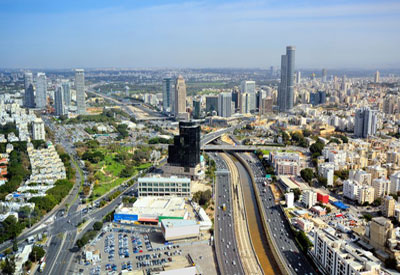Israel is situated in southwestern Asia along the eastern end of the Mediterranean Sea and borders Lebanon in the north, Syria in the northeast, Jordan in the east, and Egypt on the southwest. Furthermore, the West Bank and Gaza Strip are also adjacent.
Israel is a global leader in high-tech and environmental solutions, exporting all kinds of water technologies to the world, as well as in in cutting-edge technology, in medical research and in the arts. Its population is a linguistically and culturally diverse.
:: Background of Israel ::
Following World War II, the British withdrew from their mandate of Palestine, and the UN partitioned the area into Arab and Jewish states, an arrangement rejected by the Arabs. Subsequently, the Israelis defeated the Arabs in a series of wars without ending the deep tensions between the two sides. The territories Israel occupied since the 1967 war are not included in the Israel country profile, unless otherwise noted. On 25 April 1982, Israel withdrew from the Sinai pursuant to the 1979 Israel-Egypt Peace Treaty.
In this Country Profile
In keeping with the framework established at the Madrid Conference in October 1991, bilateral negotiations were conducted between Israel and Palestinian representatives and Syria to achieve a permanent settlement. Israel and Palestinian officials signed on 13 September 1993 a Declaration of Principles (also known as the “Oslo Accords”) guiding an interim period of Palestinian self-rule. Outstanding territorial and other disputes with Jordan were resolved in the 26 October 1994 Israel-Jordan Treaty of Peace. In addition, on 25 May 2000, Israel withdrew unilaterally from southern Lebanon, which it had occupied since 1982. In April 2003, US President BUSH, working in conjunction with the EU, UN, and Russia – the “Quartet” – took the lead in laying out a roadmap to a final settlement of the conflict by 2005, based on reciprocal steps by the two parties leading to two states, Israel and a democratic Palestine. However, progress toward a permanent status agreement was undermined by Israeli-Palestinian violence between September 2003 and February 2005. An Israeli-Palestinian agreement reached at Sharm al-Sheikh in February 2005, along with an internally-brokered Palestinian ceasefire, significantly reduced the violence.
In the summer of 2005, Israel unilaterally disengaged from the Gaza Strip, evacuating settlers and its military while retaining control over most points of entry into the Gaza Strip. The election of HAMAS in January 2006 to head the Palestinian Legislative Council froze relations between Israel and the Palestinian Authority (PA). Ehud OLMERT became prime minister in March 2006; following an Israeli military operation in Gaza in June-July 2006 and a 34-day conflict with Hizballah in Lebanon in June-August 2006, he shelved plans to unilaterally evacuate from most of the West Bank. OLMERT in June 2007 resumed talks with the PA after HAMAS seized control of the Gaza Strip and PA President Mahmoud ABBAS formed a new government without HAMAS.
:: Geography of Israel ::
Location: Middle East, bordering the Mediterranean Sea, between Egypt and Lebanon.
Geographic coordinates: 31 30 N, 34 45 E
Area:
total: 20,770 sq km
land: 20,330 sq km
water: 440 sq km
Area – comparative: slightly smaller than New Jersey
Land boundaries: total: 1,017 km
border countries: Egypt 266 km, Gaza Strip 51 km, Jordan 238 km, Lebanon 79 km, Syria 76 km, West Bank 307 km
Maritime claims:
territorial sea: 12 nm
continental shelf: to depth of exploitation
Climate: temperate; hot and dry in southern and eastern desert areas
Terrain: Negev desert in the south; low coastal plain; central mountains; Jordam Rift Valley:
Elevation extremes:
lowest point: Dead Sea -408 m
highest point: Har Meron 1,208 m
Natural resources: timber, potash, copper ore, natural gas, phosphate rock, magnesium bromide, clays, sand.
Land use:
arable land: 15.45%
permanent crops: 3.88%
other: 80.67% (2005)
Natural hazards: sandstorms may occur during spring and summer; droughts; periodic earthquakes.
Environment – current issues: limited arable land and natural fresh water resources pose serious constraints; desertification; air pollution from industrial and vehicle emissions; groundwater pollution from industrial and domestic waste, chemical fertilizers, and pesticides.
Environment – international agreements: party to: Biodiversity, Climate Change, Climate Change-Kyoto Protocol, Desertification, Endangered Species, Hazardous Wastes, Ozone Layer Protection, Ship Pollution, Wetlands, Whaling. Signed, but not ratified: Marine Life Conservation.
:: People of Israel ::
Population: 7,112,359
note: includes about 187,000 Israeli settlers in the West Bank, about 20,000 in the Israeli-occupied Golan Heights, and fewer than 177,000 in East Jerusalem (July 2008 est.)
Age structure:
0-14 years: 28% (male 1,018,229/female 971,083)
15-64 years: 62.2% (male 2,242,928/female 2,183,688)
65 years and over: 9.8% (male 303,289/female 393,142) (2008 est.)
Median age:
total: 28.9 years
male: 28.2 years
female: 29.7 years (2008 est.)
Population growth rate: 1.713% (2008 est.)
Birth rate: 20.02 births/1,000 population (2008 est.)
Death rate: 5.41 deaths/1,000 population (2008 est.)
Net migration rate: 2.52 migrant(s)/1,000 population (2008 est.)
Sex ratio:
at birth: 1.05 male(s)/female
under 15 years: 1.05 male(s)/female
15-64 years: 1.03 male(s)/female
65 years and over: 0.77 male(s)/female
total population: 1 male(s)/female (2008 est.)
Infant mortality rate:
total: 4.28 deaths/1,000 live births
male: 4.43 deaths/1,000 live births
female: 4.12 deaths/1,000 live births (2008 est.)
Life expectancy at birth:
total population: 80.61 years
male: 78.54 years
female: 82.79 years (2008 est.)
Total fertility rate: 2.77 children born/woman (2008 est.)
HIV/AIDS – adult prévalence rate: 0.1% (2001 est.)
HIV/AIDS – people living with HIV/AIDS: 3,000 (1999 est.)
HIV/AIDS – deaths: 100 (2001 est
Nationality: noun: Israeli(s) adjective: Israeli
Ethnic groups: Jewish 76.4% (of which Israel-born 67.1%, Europe/America-born 22.6%, Africa-born 5.9%, Asia-born 4.2%), non-Jewish 23.6% (mostly Arab) (2004)
Religions: Jewish 76.4%, Muslim 16%, Arab Christians 1.7%, other Christian 0.4%, Druze 1.6%, unspecified 3.9% (2004)
Languages: Hebrew (official), Arabic used officially for Arab minority, English most commonly used foreign language
Literacy:
definition: age 15 and over can read and write
total population: 97.1%
male: 98.5%
female: 95.9% (2004 est.)


Sorry, the comment form is closed at this time.